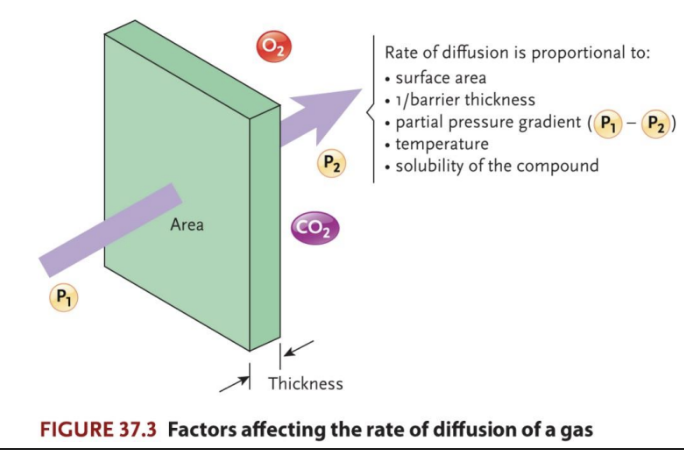BIOL 371 FINAL Flashcards
1/354
Earn XP
Description and Tags
BIOL 371 UofC Final
Name | Mastery | Learn | Test | Matching | Spaced |
|---|
No study sessions yet.
355 Terms
Flashcards Marked With “*”
Only memorize if there is extra time to
THEME 4: ANIMALS
Define Homeostasis
The maintenance of a stable internal environment suitable for metabolic processes, through responses to deviations from this stable state
What is the Significance of Homeostasis? (2)
1) Biochemical reactions are sensitive (require stable environment)
Temperature, pH, [solute], [water], pressure
2) Organisms must regulate many internal variables
Nutrients, gasses, pH, waste products, water/solutes, volume, pressure, temperature
Define Negative Feedback Loops
Homeostasis is maintained by regulating physiological variables with reference to a setpoint (generally in the integrator)
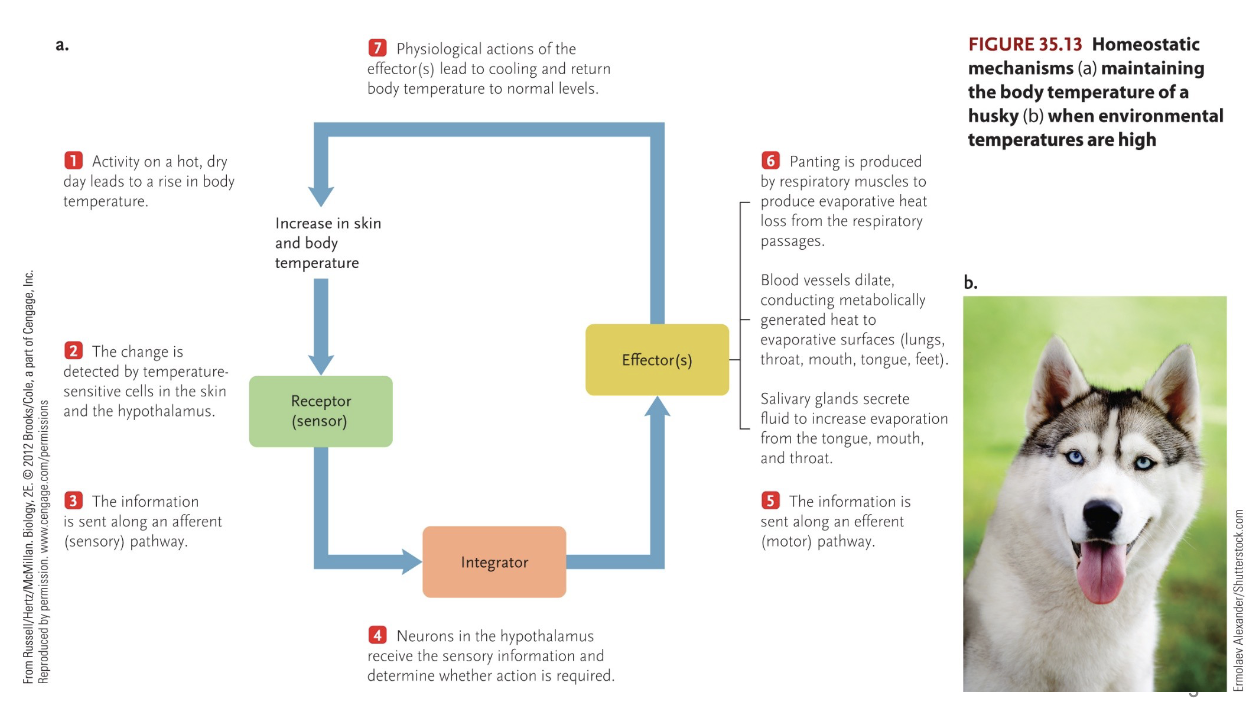
Homeostasis - Cell Location (Definition + 3 Implications)
Cell Location: Implications for how homeostasis is approached
1) External cells must face the environment
2) Cells of exchange surfaces must be alive
3) Internal cells provide homeostasis through regulation of internal environment
External cells must face the environment (2)
Sometimes dead (i.e. superficial layers of skin)
Sometimes protected by an acellular cuticle
Cells of exchange surfaces must be alive (3)
Control access to internal environment
Found inside the body, but dealing with aspects of the external environment
Deal with wear & tear by: rapid turnover, produce lethal environment to microbes, covered by secretions to isolate them from the environment
*Internal cells: homeostasis by organism regulates the internal environment (example + 2)
E.g. Regulation of extracellular fluid solute content & volume
Reduces amount of work cells have to do to maintain homeostasis, if internal cells are not isoosmotic with the environment
Enables them to specialize
Define Osmoregulation
Regulation of the internal osmotic (water/salt/waste) environment
Define Circulation
Bulk flow of fluid within the body (water, solutes, nutrients, gasses)
Define Gas Exchange
Exchanging gasses with the environment
Define pH Regulation
Controlling the [proton (H+)] of body fluids
Define Water Potential (2)
Tendency of water to move due to osmosis, hydrostatic pressure, gravity, humidity, etc.,
Sum of osmotic potential, pressure potential, gravity, etc., across a membrane
Define Bulk Flow
Mass movement over long distances due to mechanical (hydrostatic) pressure
Define Diffusion
The movement of molecules a short distance from a region of higher concentration to a region of lower concentration down the concentration gradient to establish an equilibrium
Define Concentration Gradient
A spatial difference in the relative abundance of one type of molecule (or atom)
Fick’s Law (Equation + 4 Components)
Diffusion rate across a membrane = D A dC/dX
D = Diffusion coefficient - depends upon the characteristics of the solute and solvent, temperature, etc.,
A = Surface area of the membrane
dC = Concentration difference across a membrane
dX = thickness of the membrane
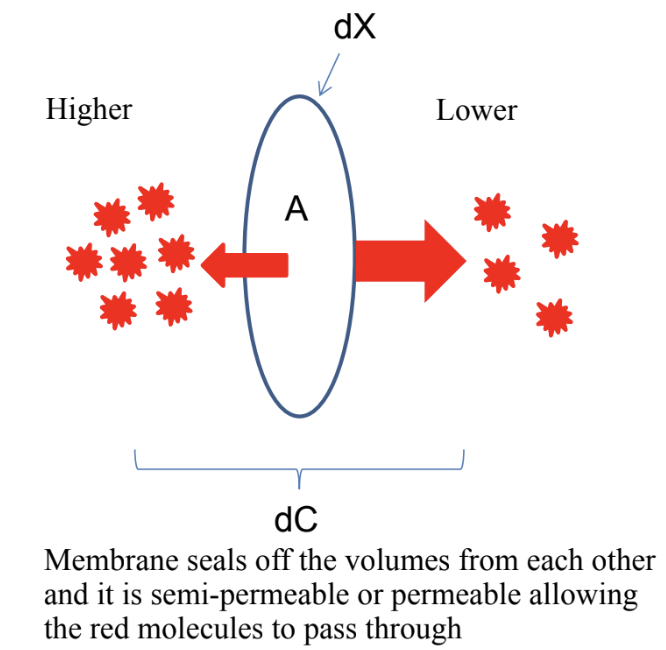
___ is the force driving diffusion
dC/dX
The quantity of particles moving across the membrane varies with ___, all else being equal
A
Define Osmoles
Total number of dissolved particles of solute per kg of solvent
E.g. 1 mole of NaCl dissolved in 1 kg of water yields 2 moles of particles - 1 mole Na+, 1 mole Cl-
Define Osmolality
Osmotic concentration of a solution, measured in osmoles
Define Hypoosmotic
A solution having a lower osmolality than the reference solution (having a lesser concentration of solutes)
E.g. Pure water is hypoosmotic to the red blood cell placed in it, which bloats (water goes into the cell)
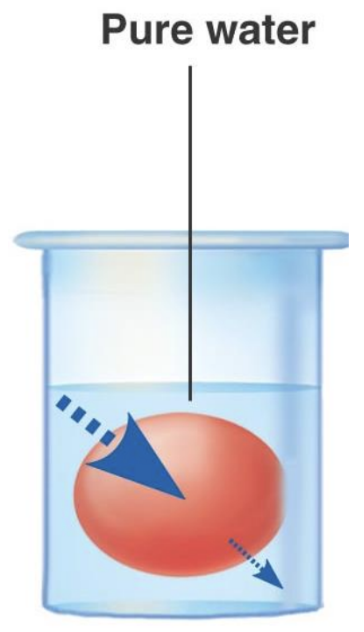
Define Hyperosmotic
A solution having a higher osmolality than the reference solution (having a higher concentration of solutes)
E.g. A strong saline solution is hyperosmotic to the red blood cell placed within it, which shrivels (water moves from inside to the outside of the cell)
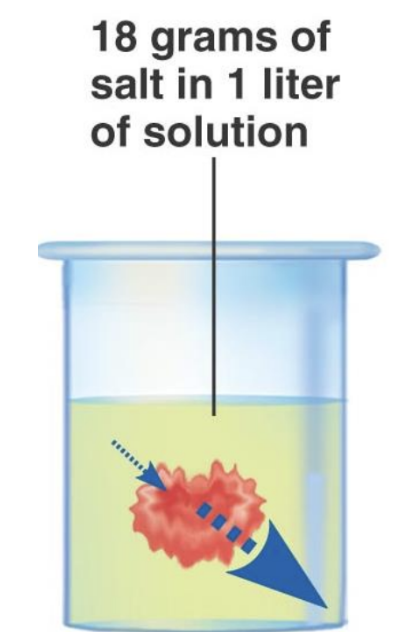
Define Isoosmotic
A solution having the same osmolality as the reference solution (same concentration of solutes)
E.g. A bath of physiological saline is isoosmotic to the red blood cell placed within it, which stays the same (both environments, outside and inside, are the same & there is no net movement of water)

Define Osmosis
The tendency of water to diffuse across a selectively permeable membrane towards the side of greater solute concentration when the membrane is impermeable to the solute
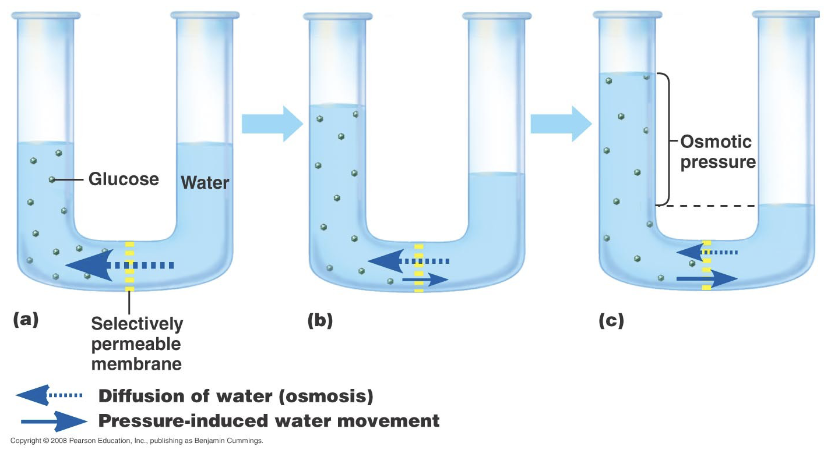
Define Osmotic Potential (a.k.a soluble potential in plants)
Force exerted on water generated by differences in solute concentration across a semi-permeable membrane
Pure water has an osmotic potential of ___ - highest osmotic potential possible
Zero
Lower osmotic potential is a ___
Negative number (the more solute, the more negative the osmotic potential)
Water moves from ___ to ___ volumes
Less negative
More negative
Define Pressure Potential
Hydrostatic (mechanical) pressure affecting how water crosses membrane from volume of high osmotic potential to volume of low osmotic potential
What Happens When Pressure Potential is Opposed to Low Osmotic Potential?
Flow of water across membrane decreased, reversed or stopped
What Happens When Pressure Potential is Added to Low Osmotic Potential?
Flow of water across membrane increased
Pressures measured in ___ or ___
Pascals (Pa - animals)
Ψ (Psi - plants)
Water moves from volumes of ___ to volumes of ___
High water potential
Low water potential
Osmosis & The Living Cell: Significance to Animals
Cells will shrink or swell if not in an isoosmotic environment (without work on cell’s part)
Net movement of water into the cell causing it to burst, or out of the cell shrivelling the cell (death in both cases)
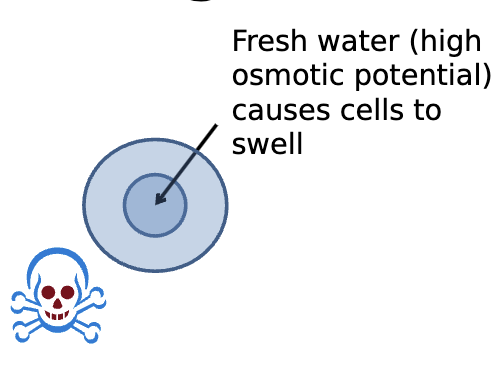
Osmosis & The Living Cell: Significance to Plants
Cells will develop turgor pressure (hydrostatic) due to cell swelling and pressing against cell wall as water enters, which limits further influx of water
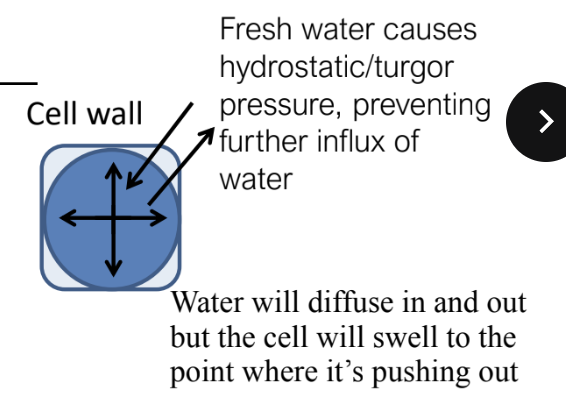
Bulk flow of transport fluids in animals requires application of ___
Hydrostatic pressure
Affects exchange of water and solute between the bulk transport system and the extracellular fluid in closed circulatory systems
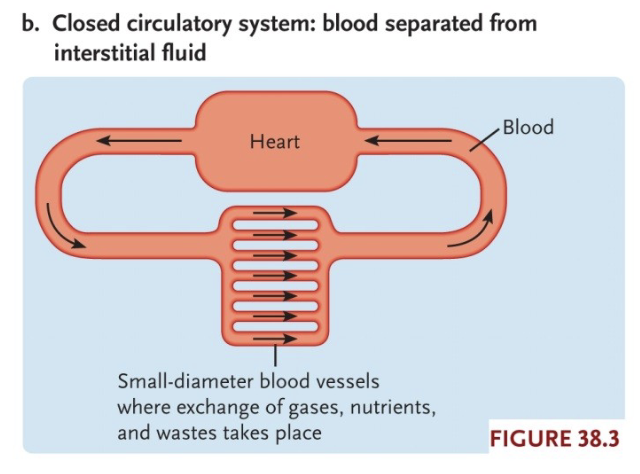
Hydrostatic pressure exerted on blood in upstream side of capillary bed ___
Exceeds osmotic potential of extracellular fluid
Water and solutes leave capillaries
Osmotic potential of blood in downstream side of capillary bed ___
Exceeds hydrostatic pressure of extracellular fluid
Water and solutes re-enter capillaries
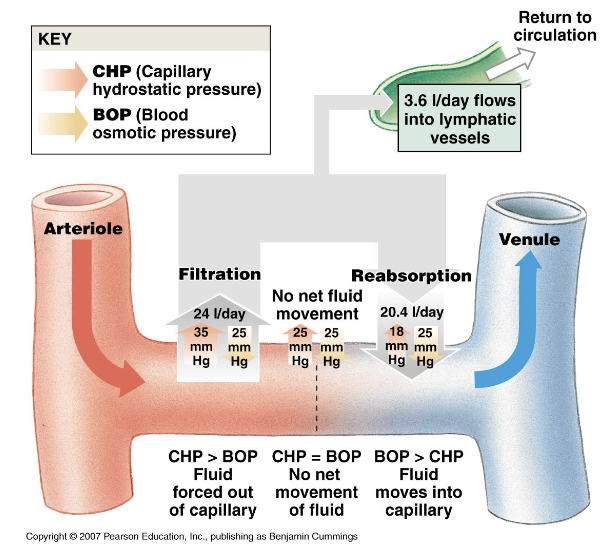
Osmoregulation in Animals: Osmoconformer Strategies
Adjust osmotic potential of cells [Y] & extracellular fluid [X] to match environment [Z]
Adjust internal environment to external (isoosmotic)
Examples: Marine inverts, hagfish, elasmobranchs
![<p>Adjust osmotic potential of cells [Y] & extracellular fluid [X] to match environment [Z]</p><ul><li><p>Adjust internal environment to external (isoosmotic)</p></li><li><p>Examples: Marine inverts, hagfish, elasmobranchs</p></li></ul><p></p>](https://knowt-user-attachments.s3.amazonaws.com/20fe0b32-0eb3-463e-9a45-be05a126a30e.png)
Osmoregulation in Animals: Osmoregulators Strategies
Adjust osmotic potential of extracellular fluid [X] to match cells [Y] and regulate or protect [X] against the external [Z]
Generally requires thick outer layer
Spending effort
Examples: Freshwater inverts & most vertebrates
![<p>Adjust osmotic potential of extracellular fluid [X] to match cells [Y] and regulate or protect [X] against the external [Z]</p><ul><li><p>Generally requires thick outer layer</p></li><li><p>Spending effort</p></li><li><p>Examples: Freshwater inverts & most vertebrates</p></li></ul><p></p>](https://knowt-user-attachments.s3.amazonaws.com/091c854f-8d3b-48bc-82e8-f655dd2931b5.png)
Terrestrial Animals: Water/Salt; Gain/Loss
Terrestrial environments are dry, lose water to the environment

Marine Animals: Water/Salt; Gain/Loss
Marine environments are hyperosmotic (dry), lose water and gain salt from the environment

Freshwater Animals: Water/Salt; Gain/Loss
Freshwater environments are hyposmotic, gain water and lose salt to the environment

Body fluid ___ varies among aquatic organisms
osmolality
Some marine groups are ___ with seawater
Isoosmotic
Tonicity & The Environment: Marine Bony Fish (4)
Hypoosmotic to environment, lose water and gain ions, especially through the gills
Drink seawater to offset water loss
Chloride cells in gills eliminate Na+, K+, & Cl- from blood (pump ions out from extracellular fluid to environment, pumped against concentration gradient, requires energy in the form of ATP)
Produce small amounts of urine, conserving water, eliminating excess solute in feces
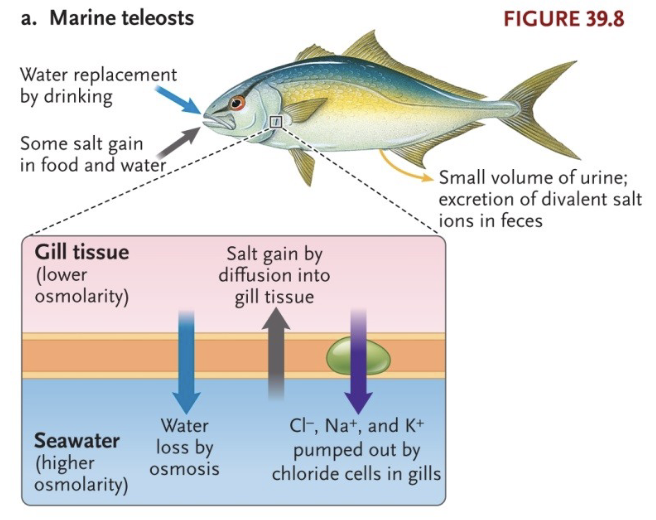
Tonicity & The Environment: Freshwater Bony Fish (4)
Hyperosmotic to environment, lose ions and gain water, especially through the gills
Do not drink water
Produce large amounts of dilute urine (getting rid of water)
Must replace ions from food or from transport across gill membrane
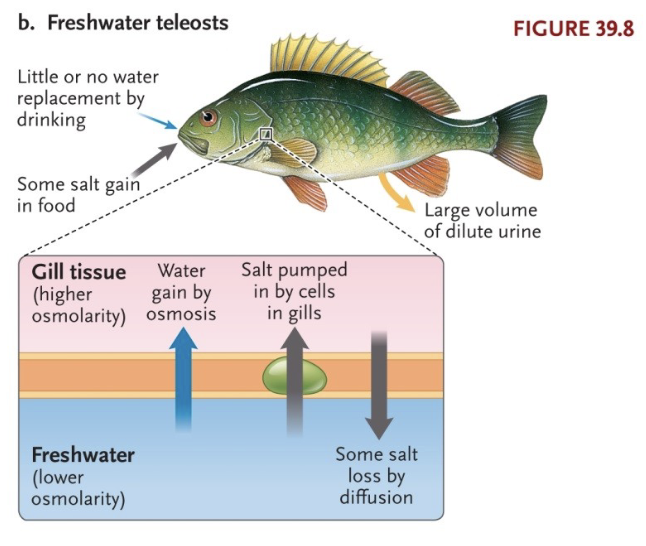
Tonicity & The Environment: Elasmobranchs (2)
Isoosmotic to seawater, but concentrations of Na+, K+, Cl- all less than seawater, difference is made up by urea
Still must deal with inward diffusion of Na+, K+, Cl- through gills, rectal gland secretes a highly concentrated salt solution
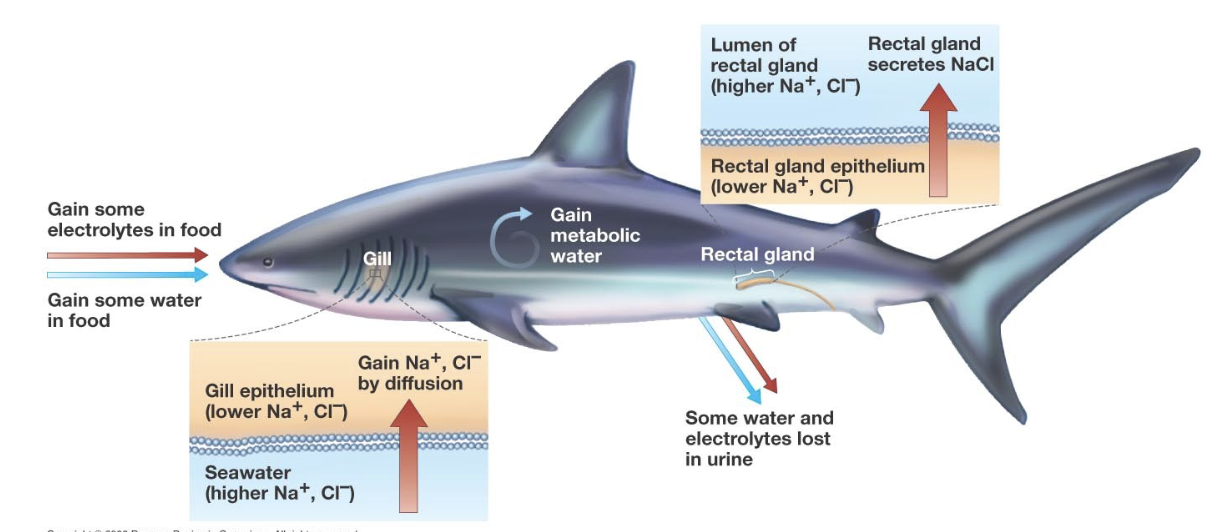
*Tonicity & The Environment: Land Dwellers (2)
A dry environment = constant water loss through evaporation (across wet respiratory membrane, and across surface of skin)
Water loss in urine and feces (waterproofing of outer layer of body, minimal exposure of gas exchange and digestive surfaces to air, minimizing electrolyte intake)
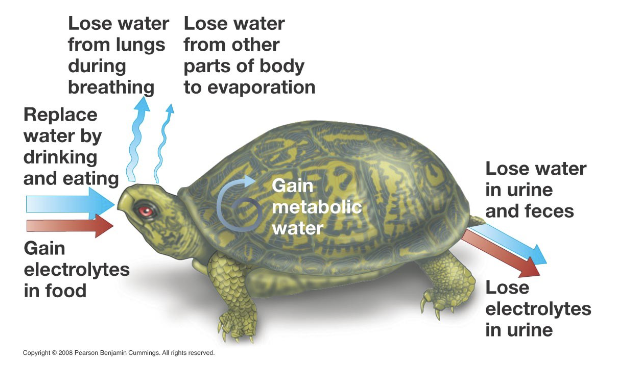
Define Excretion
Elimination of waste/toxins
Aids in controlling content of extracellular fluid (salt/water/pH)
Major Means of Excretion in Animals (4)
Diffusion into water (only in aquatic habitats)
Actions of excretory tubule (liquid waste):
Filtration (non-selective): Small molecules & ions from body fluids or blood nonselectively pass through narrow spaces between cells into the tubule (hydrostatic pressure)
Secretion (selective): Excess ions & toxic breakdown products are transported selectively from the body fluids or blood into the tubule (move ions to extracellular fluid)
Reabsorption (selective): Nutrient molecules, some ions, and conserved water are returned to the body fluids or blood by transport equilibrium (only certain ions move)
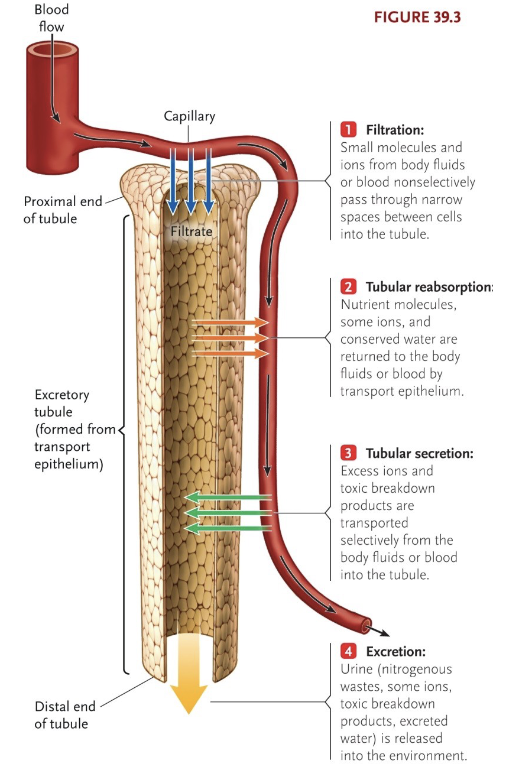
Excretory Tubule (2)
Composed of transport epithelium, allows active transport of ions between ECF and filtrate
Other solutes and water diffuse in either direction
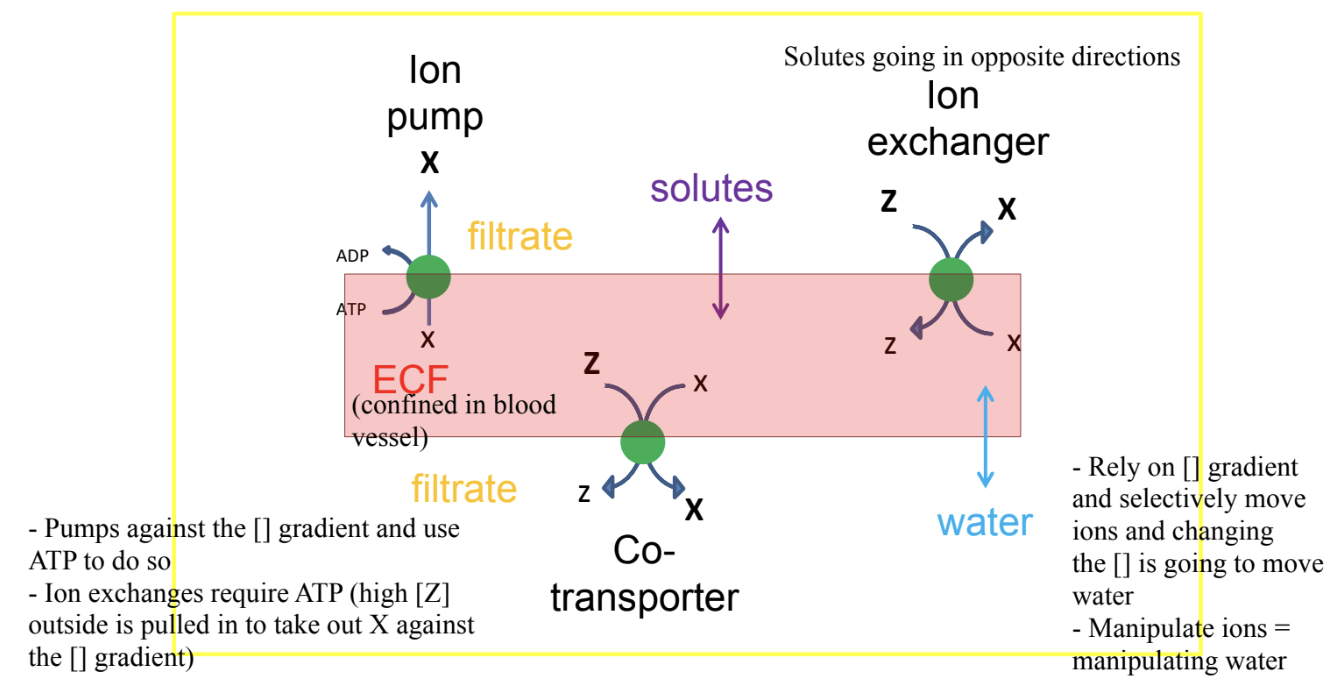
Filtration, reabsorption, & secretion result in production of ___
urine/filtrate
Different Functions of Excretory Tubule Localized Along Its Length (3)
Filtration (isoosmotic): ECF/plasma enter excretory tubule
Reabsorption (hyperosmotic): Occurs in proximal region of excretory tubule which contains water permeable membrane, and ions, sugars, and water leave excretory tubule
Secretion (hyperosmotic): Occurs in distal region of excretory tubule which contains water impermeable membrane, and unwanted ions enter excretory tubule
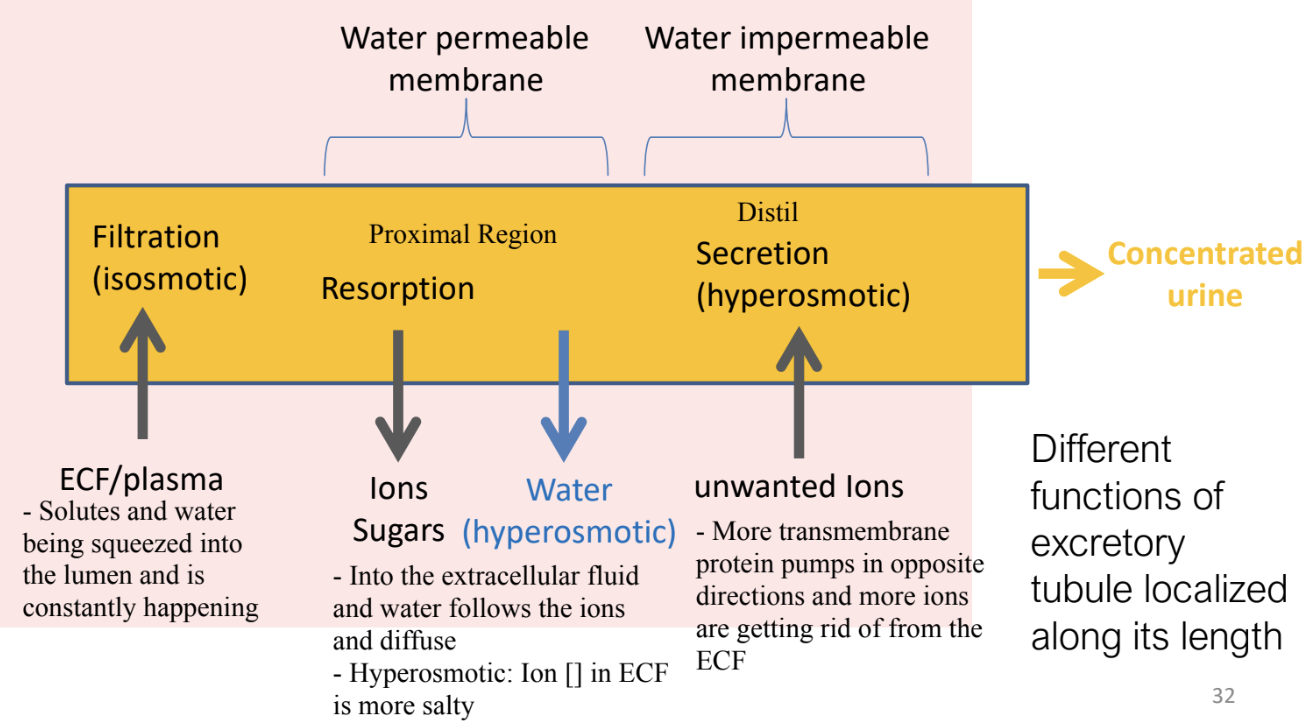
Ammonia (NH3) Excretion
Ammonia is toxic, we must get rid of it
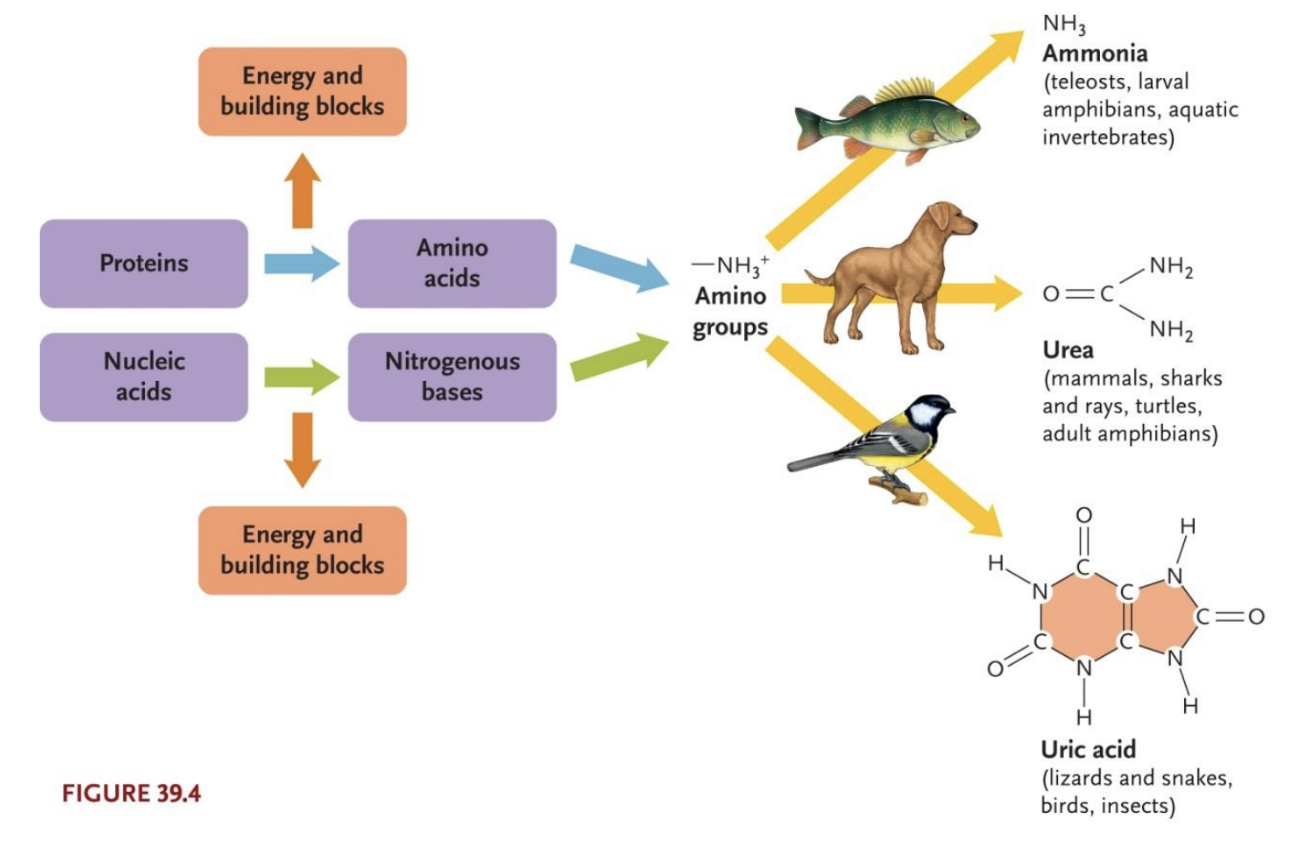
Ammonia (NH3) Excretion: Aquatic Animals (3)
Diffusion into the environment (across body/gills)
Excretion in filtrate/urine
Ammonium (NH4+)/sodium exchangers

Ammonia (NH3) Excretion: Terrestrial (& some aquatic) Animals (3)
Terrestrial animals cannot use diffusion or ion exchange with air (only excretion in filtrate)
Produce urea (mammals, amphibians, sharks)
Produce uric acid (land snails, insects, reptiles/birds; key for animals that develop in terrestrial eggs)
Protonephridium (4)
Filters extracellular fluid
Eliminates waste by means of current produced by ciliated flame cell
Drains into series of ducts
Reabsorption takes place in the ducts
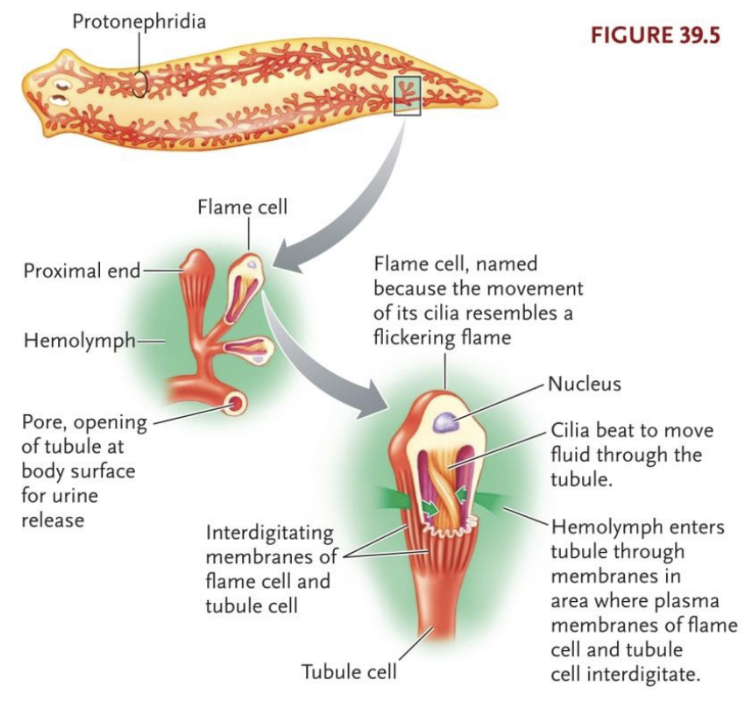
Metanephridium (2)
Filters coelomic fluid, reabsorption into circulatory system through blood vessels
Associated with closed circulatory system
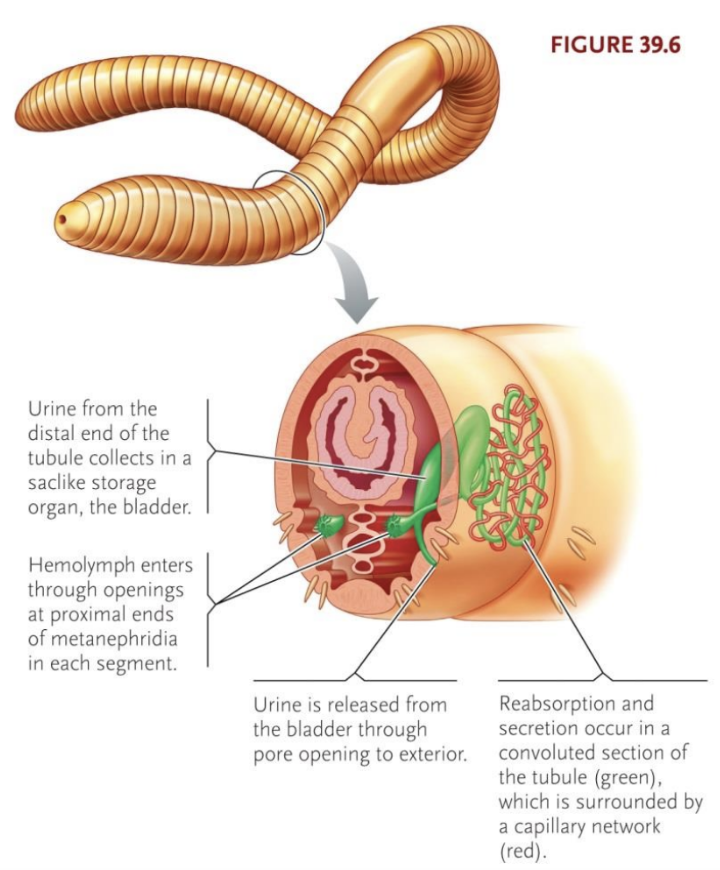
Malpighian Tubules (6)
Large absorptive surface area in contact with haemolymph involved in active secretion of uric acid,
Ions into lumen of tubule
Water follows through osmosis
Filtrate released into gut
Na+ and K+ actively transported out, water follows
Solid uric acid released with faeces
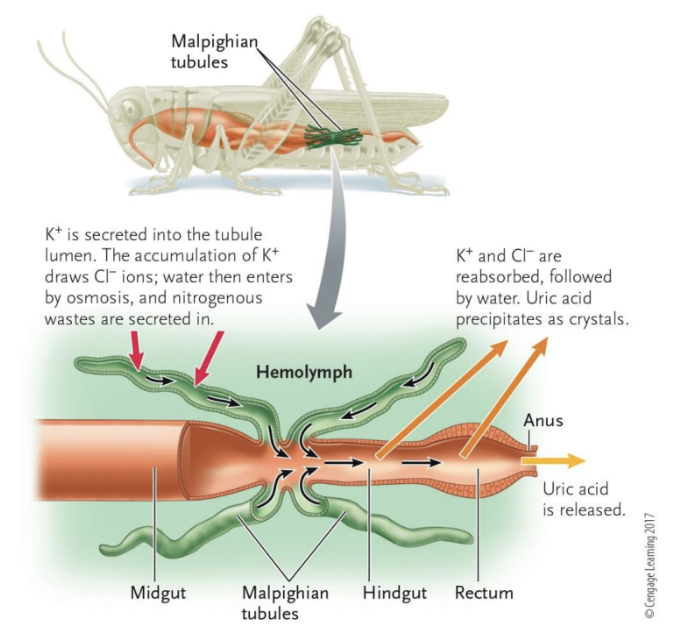
Nephron (2)
Found in vertebrates
Filters water and solutes from blood, reabsorbs water and solutes to produce concentrated urine
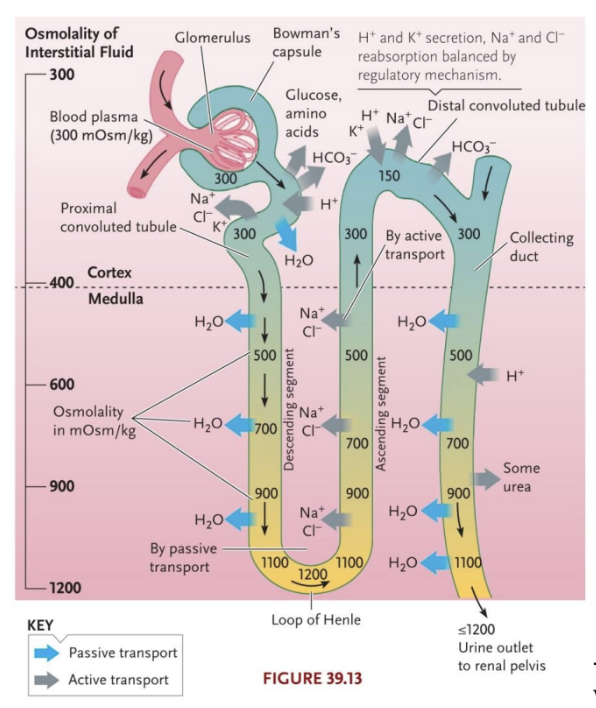
Loop of Henle (2)
Important in formation of concentrated urine
Blood plasma is squeezed out into the Loop of Henle which is found in mammals (this region has high osmolality)
Homeostasis & Circulation: Why Circulate Fluids? (2)
Processing
(regulate pH, osmolarity, waste, add nutrients, gas exchange)
Transportation and communication (hormones, heat, gasses, nutrients, immune components, solutes)
___ is adqeuate in small (>1mm thick) simple organisms, larger require a circulatory system
Diffusion
*Homeostasis & Circulation: Plants vs Animals (4)
Both use a series of tubes, but differ in:
Nutrient, energy, and water sources
Metabolic rates
Cell structure
Presence or absence of muscle
*Circulation in Animals (7)
Occurs in heterotrophs with extracellular digestion
High metabolic rates demand rapid circulation
Tissues require oxygen, nutrients, and respiratory wastes must be carried away
Move (vessels of system must be flexible)
Muscular pump and flexible tubes (vasculature) for circulation
Fluids must be forced through the vessels
A cardiovascular system (pump and vessels)
Circulation in Animals: Open Circulatory System (2)
Low pressure, slow, suitable for taxa with slow metabolic rates
Hemolymph: Transport fluid in open circulatory system, comes into direct contact with tissues (extracellular fluid pool)
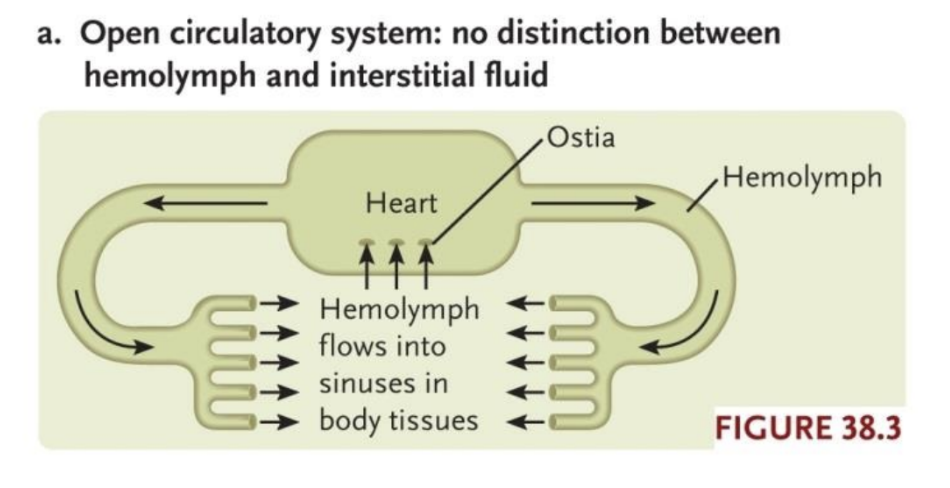
Circulation in Animals: Open Circulatory System (Continuation) (5)
Heart(s) sit in hemolymph (filled hemocoel)
On contraction, hemolymph expelled from heart via major arteries to other hemolymph spaces
On relaxation, hemolymph enters heart from hemocoel
Valves in heart wall maintain unidirectional flow
Further distributed by body movements (directed flow to active tissues not possible; accessory hearts may supply limbs)
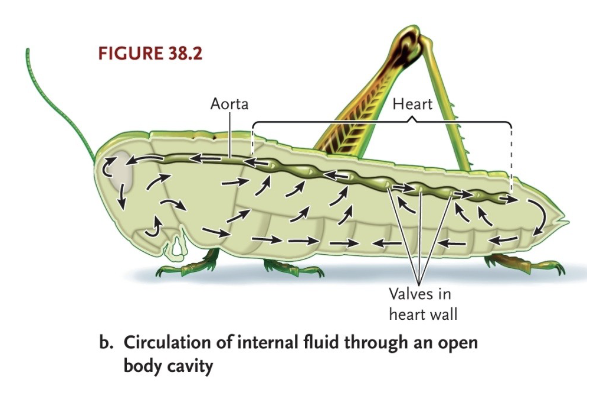
Circulation in Animals: Closed Circulatory System (3)
Blood under pressure
Blood vessels and heart form continuous closed circuit
Found in forms able to sustain prolonged high activity rates (annelids, cephalopods, some crustaceans, all vertebrates)
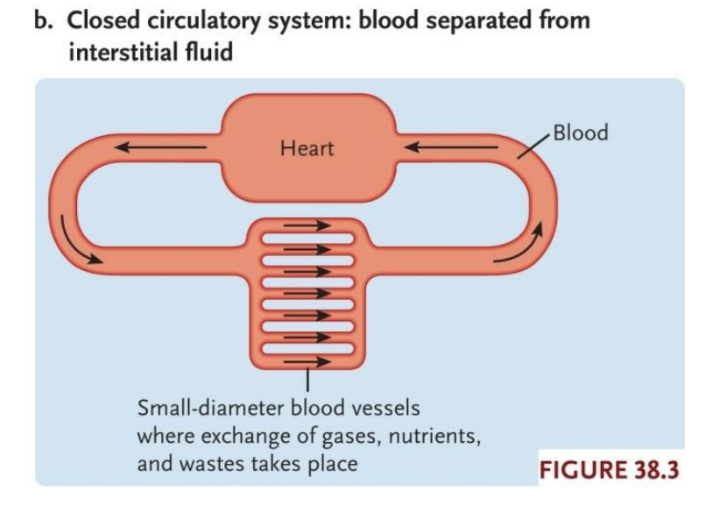
Circulation in Animals: Closed Circulatory System (Continuation) (4)
Blood contained within heart and vessels of circulatory system, not coming in direct contact with any of the tissues of the body
Blood plasma is part of the extracellular fluid pool
Capillary beds connect veins and arteries
Confinement makes regulation, direction of flow, and high flow rates possible
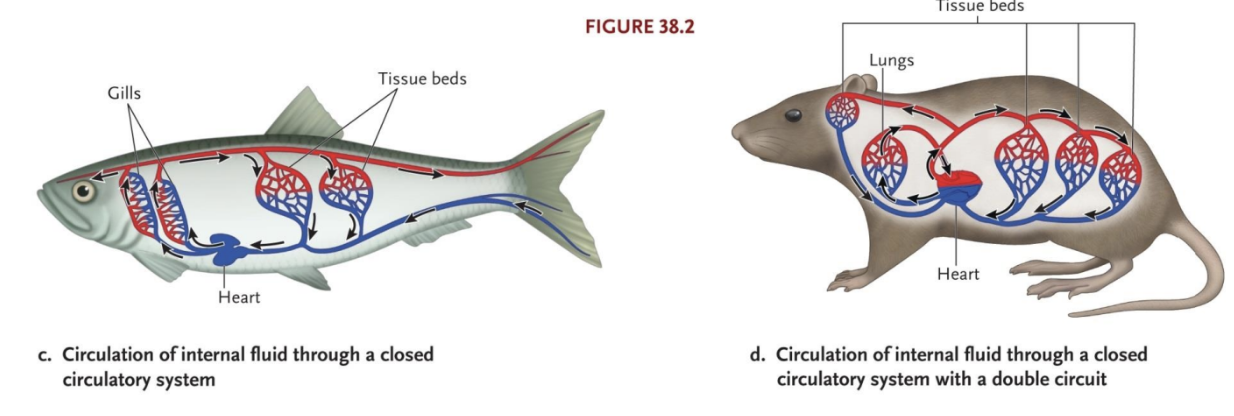
The Heart
Muscular pump; creates pressure and directional flow in vasculature in closed circulatory systems, creates directional flow in open circulatory systems
In closed circulatory systems, heart maintains bulk flow of fluids in the face of ___
Resistance
Ohm’s Law
Flow = pressure/resistance
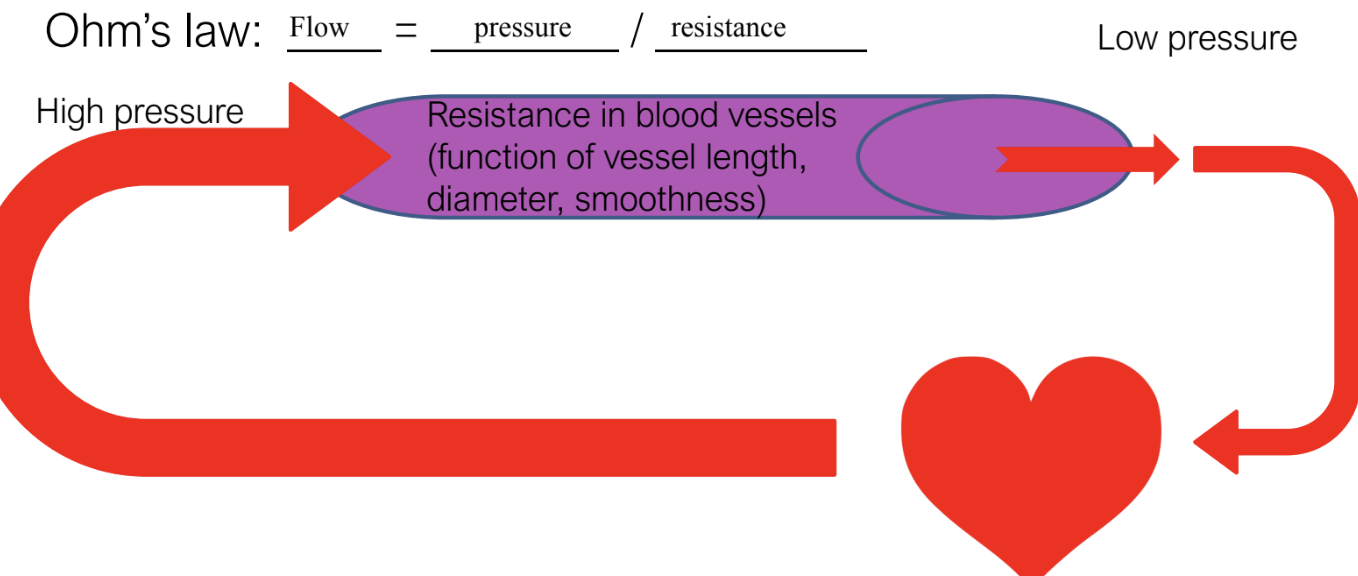
Closed Circulatory System: From Heart to Capillaries (2)
Blood pressure drops with distance from heart due to greater total volume occupied, resistance
Blood velocity decreases with distance from heart due to smaller diameters of vessels occupied, due to resistance, decreasing diameters of vessels
Closed Circulatory System: From Capillaries to Heart (2)
Blood pressure continues to drop
Blood velocity increases due to increasing diameters of fewer vessels
Blood Vessels In A Closed System (3)
1) Arteries
2) Veins
3) Capillaries
Arteries (Efferent Vessels) (3)
Carry fluid away from heart
Control blood distribution to the body by controlling vessel diameter (resistance)
Depulsate pressure waves from the beating heart (elastic - expand/contract)
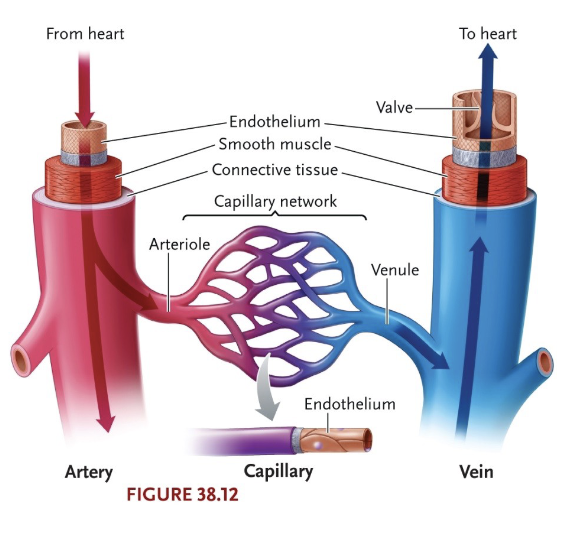
Veins (Afferent Vessels) (2)
Carry fluid back to heart
Store blood (easily expand)
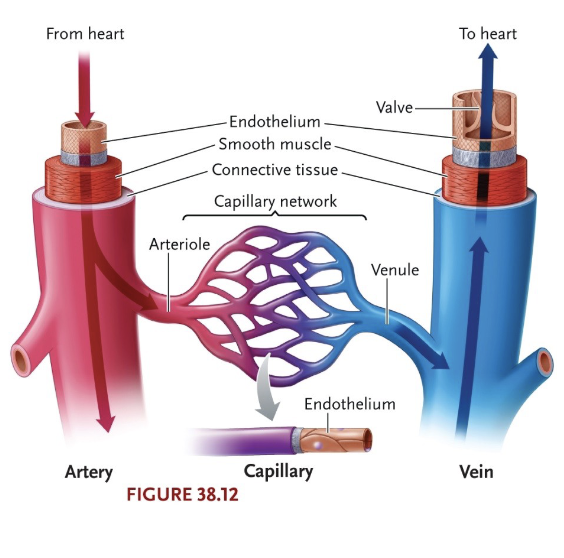
Capillaries (3)
Exchange of substances between blood & tissues (gas, fluids, solutes, nutrients, waste)
Morphology of wall permits diffusion
Huge cumulative surface area
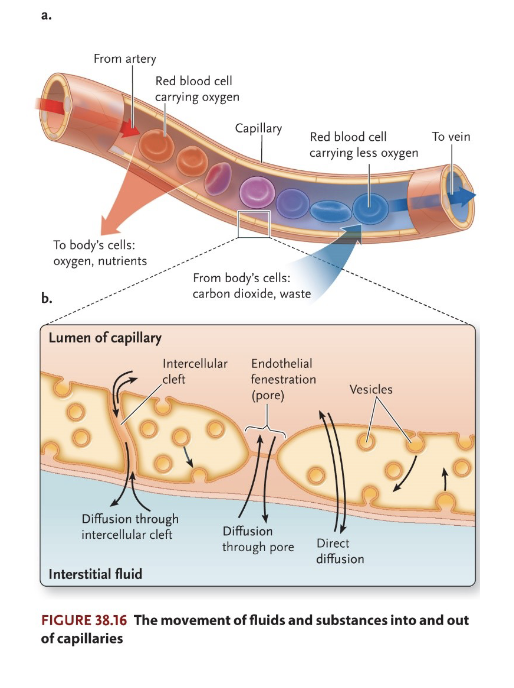
Blood (ECF) Components in Vertebrates (4)
1) Plasma
2) Erythrocytes
3) Leukocytes
4) Platelets
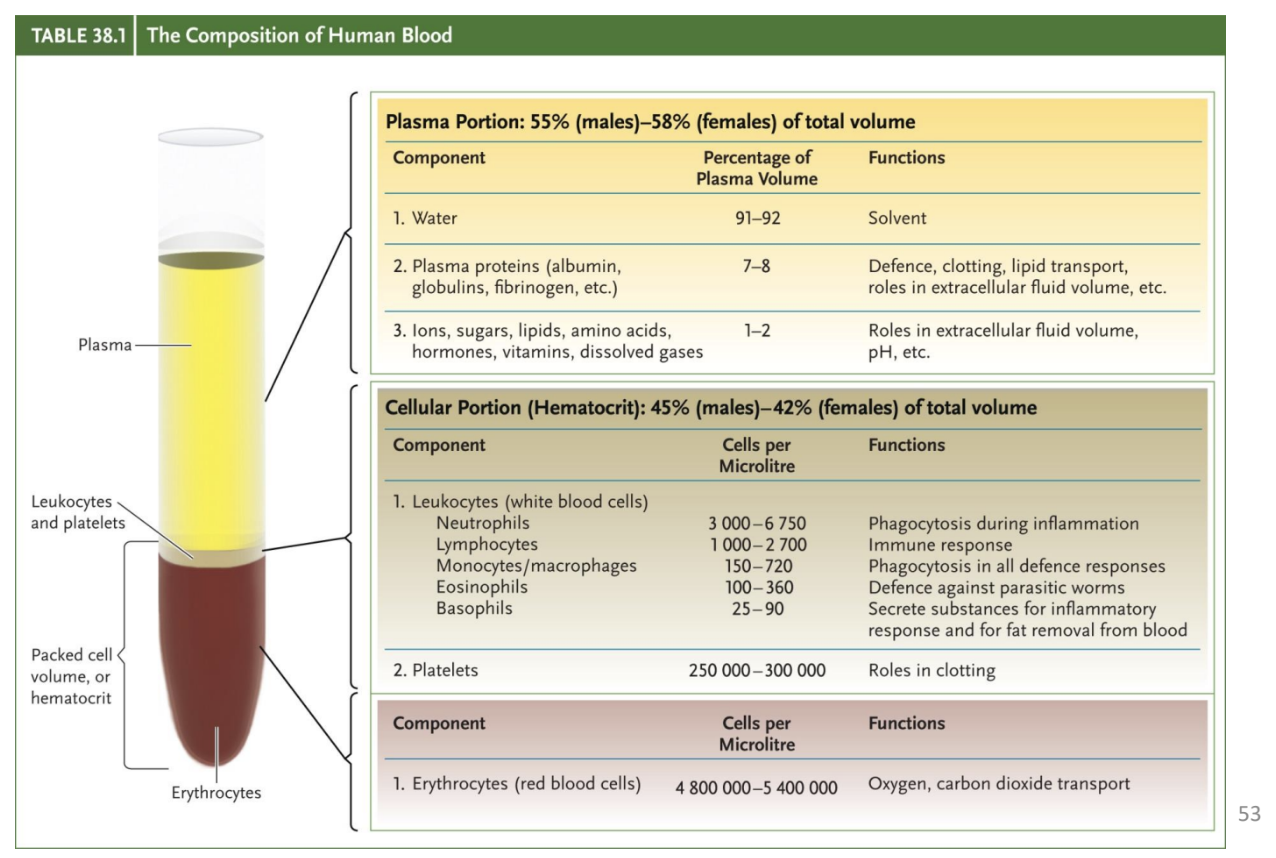
Plasma
Component of the ECF that contains water, ions, proteins, nutrients, and gas
Key ions are Na+, K+, Cl-, HCO3-, Ca+, H+
Key proteins are globulins, albumin, fibrinogens
Key gasses are O2 and CO2
Erythrocytes
Contain respiratory pigments
Haemoglobin, haemocyanin, etc.,
Increase capacity of fluid to carry O2 and CO2
Leukocytes
White blood cells (immune system)
Platelets (Thrombocytes)
Help stop bleeding by forming clots
Variation in Circulatory System in Vertebrates Associated With: (3)
Whether or not gravity is a factor affecting blood flow (requiring higher pressure)
Where gas exchange takes place (gills, lungs, or lungs and skin)
Thermoregulatory mode (endothermy or ectothermy)
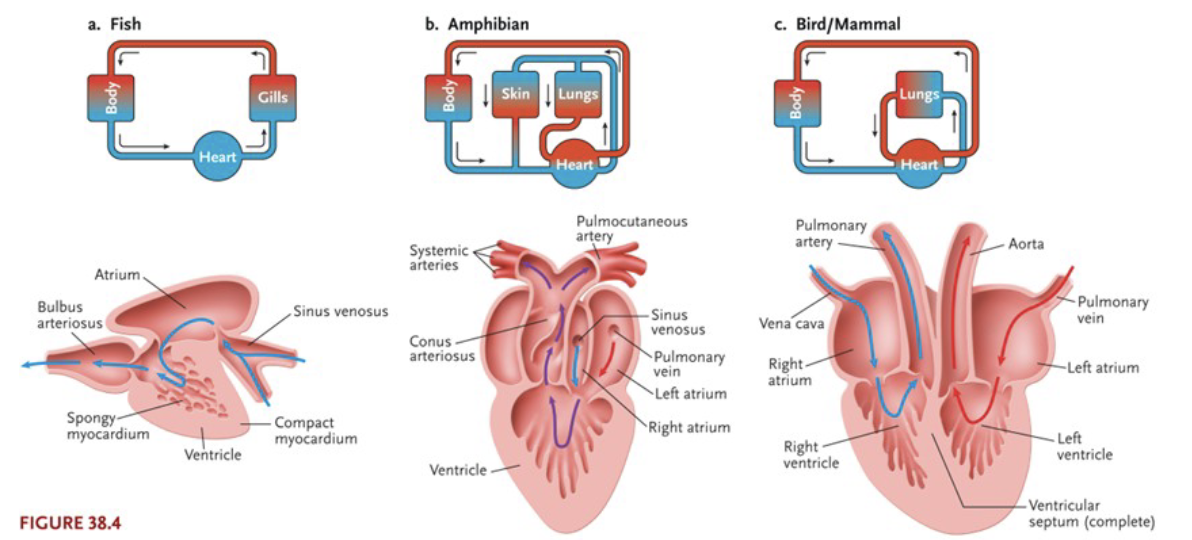
Vertebrate Circulatory Systems: Fish (3)
1) 2 chambers
Atrium: Thin-walled, receives O2-poor blood from systemic circulation
Ventricle: Thick-walled, muscular, sends O2-poor blood through aorta to gills
2) Circulatory system forms single loop (single circuit)
3) Low-pressure (effects of gravity are negligible)
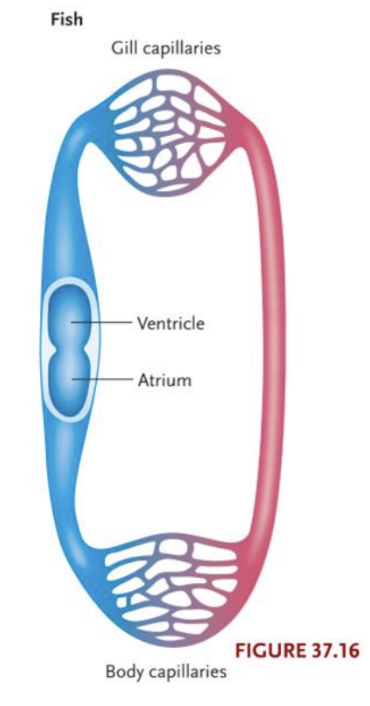
Vertebrate Circulatory Systems: Tetrapods (3)
1) Tetrapods evolved two separate circuits
Low-pressure pulmonary circuit between heart and lungs
High-pressure systemic circuit between heart and rest of the body
2) 3-4 Chambers: Each of these circuits required its own atrium, and increasing separation of the ventricle into two chambers
3) High pressure (gravity becomes a factor)
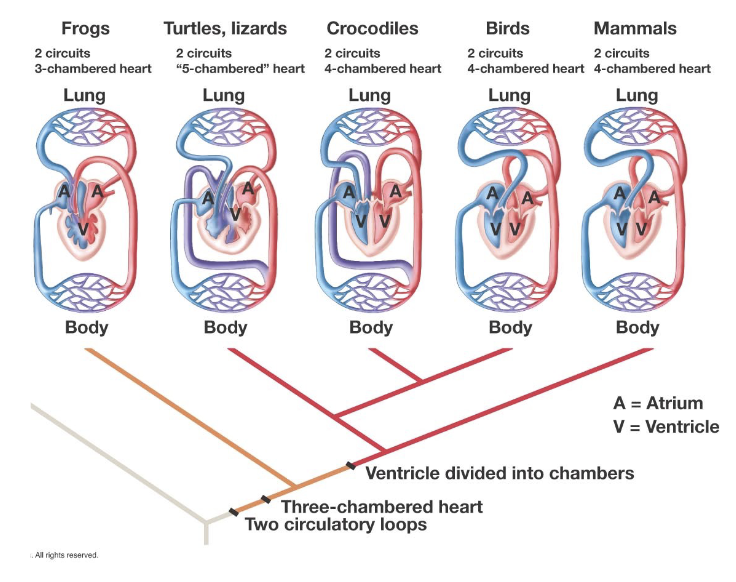
Vertebrate Circulatory Systems: Ectothermic Tetrapods (2)
1) Variable Circuit: Ectothermic tetrapods can bypass pulmonary circuit
While diving
Cutaneous respiration
2) Incomplete separation of ventricle: Ectotherms tolerate some mixture of deoxygenated blood and oxygenated blood due to low metabolic rates
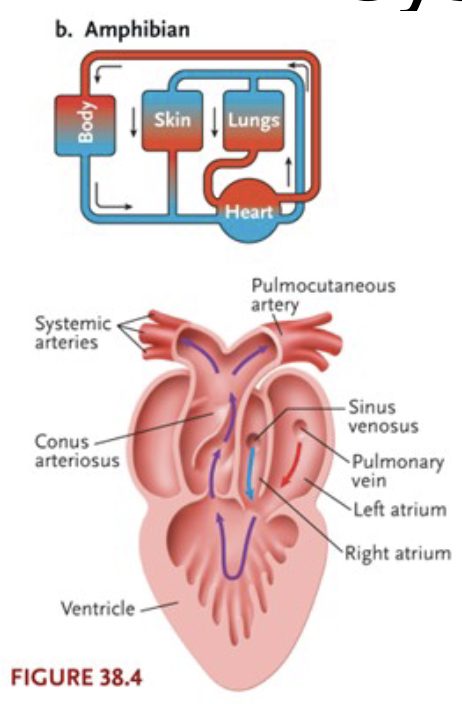
Vertebrate Circulatory Systems: Mammals and Birds (3)
1) Complete separation between ventricles
2) Double Circuit: Blood can only pass between pulmonary and systemic circuits at the heart
3) Endothermic requires efficient delivery of O2 to tissues
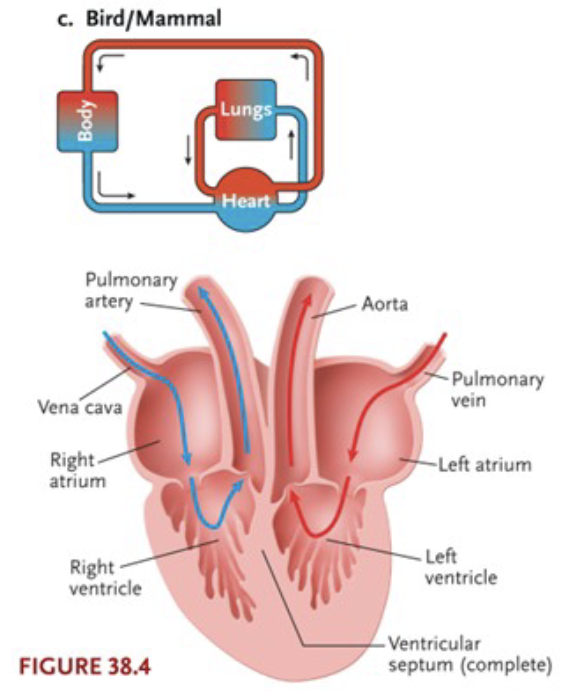
*Homeostasis and Gas Exchange: Why Is It Needed? (3)
All plants and animals must breathe
Krebs cycle and oxidative phosphorylation (consume oxygen and produce carbon dioxide)
Photosynthesis (consumes carbon dioxide and produces oxygen)
pH regulation (via CO2 regulation, forms carbonic acid)
Gas Exchange With The Environment (2)
Ventilation (Breathing)
Bulk flow between the respiratory medium (air/water) and the gas exchange surface (body surface, lungs, gills, etc.,)
Gas enters/exits extracellular fluid bulk flow system by diffusion
Gas Exchange and Gas Transport (2)
Gas exchange takes place between blood and air or water (at the respiratory membrane) and between tissues and blood (diffusion in both exchanges)
Gas transport is carried out by the blood (circulatory system)
Atmospheric Composition and Pressure (3)
Atmospheric pressure decreases with altitude
The composition of the atmosphere remains the same
Each gas making up the atmosphere contributes towards total atmospheric pressure (has a partial pressure)
Partial Pressure Gradients in The Body (4)
Diffusion in gas exchange is based on partial pressure gradients
Oxygen and carbon dioxide partial pressures differ throughout the body
CO2 produced in tissues (high partial pressure); O2 consumed in tissues (low partial pressure)
Gradients maintained by circulatory system
Gas Exchange With The ECF
Gas Exchange Surface: Diffusion between air/water and the ECF
Surface area of gas exchange surface is ___ to mass and metabolic rate
proportional
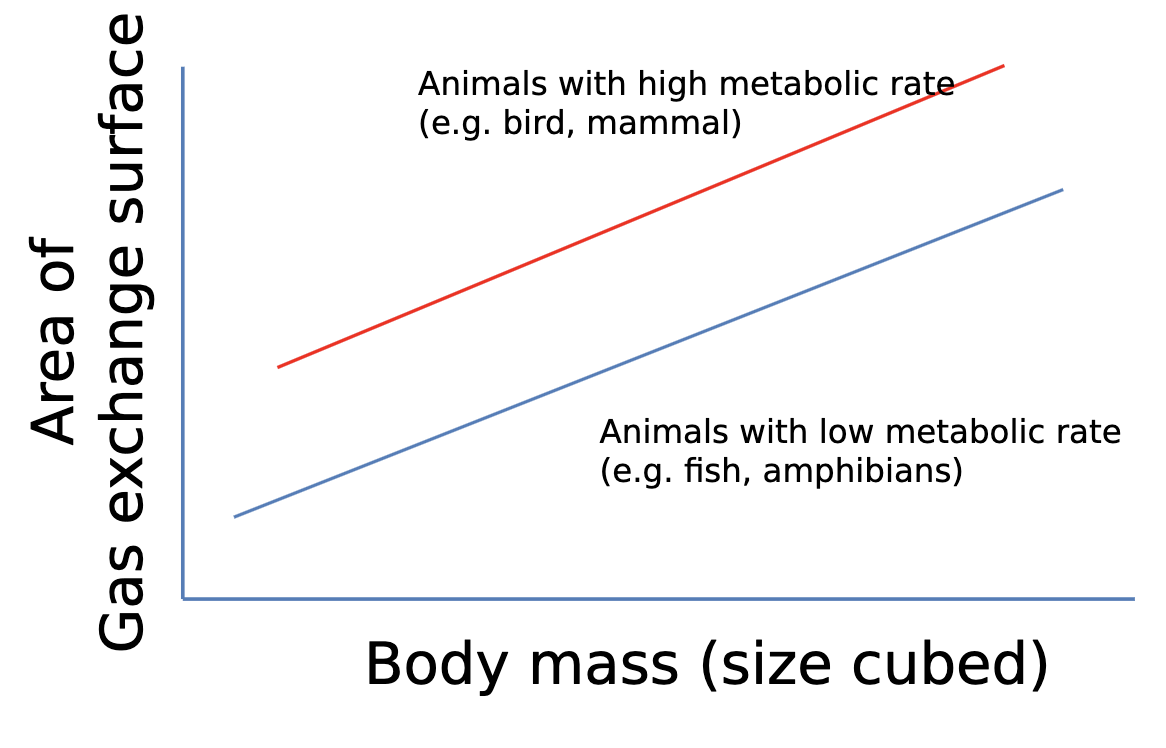
Surface Area/Volume Relationships Are Important (2)
Large animals need specialized gas exchange structures
Lungs, gills, book lungs/gills, trachea (not just body surface)
Characteristics of a Good Gas Exchange Structure (3)
Reflected in Fick’s Law of Diffusion (Rate = D A dC/dX)
Large SA
Moist
Thin
